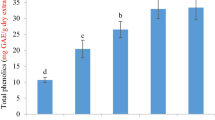Abstract
Eighty-eight extracts of different polarity obtained from 18 Lamiaceae medicinal and aromatic plants were screened for their antioxidant and antifungal properties. A TLC analysis combined with two bioassays were used to detect these activities. In most cases the highest radical scavenger capacity was detected in methanolic and aqueous extracts and polyphenols may be responsible. The most interesting antioxidant activity was observed in polar extracts obtained from Lycopus europaeus, Melissa officinalis, Origanum vulgare subsp. virens and Lavandula latifolia. On the contrary, the best results for the antifungal test against Rhizopus stolonifer were produced by non-polar herbal extracts. Phlomis lychnitis, Salvia pratensis and Calamintha sylvatica caused the highest inhibition on Rhizopus growth.
Similar content being viewed by others
References
Harman D (1956) Aging: a theory based on free radical and radiation chemistry. J Gerontol 11:298–300
Hertog MG, Feskens EJ, Hollman PC, Katan MB, Kromhout D (1993) Dietary antioxidant flavonoids and risk of coronary heart disease: the Zutphen Elderly Study. Lancet 342:1007–1011
Steinbrecher UP, Zhang HF, Lougheed M (1990) Role of oxidatively modified LDL in atherosclerosis. Free Radic Biol Med 9:155–168
Schreck R, Baeuerle PA (1991) A role for oxygen radicals as second messengers. Trends Cell Biol 1:39–42
Ross R (1993) The pathogenesis of atherosclerosis: a perspective for the 1990s. Nature 362:801–809
Maron DJ (2004) Flavonoids for reduction of atherosclerotic risk. Curr Atheroscler Rep 6:73–78
Cascales M (1999) Estres oxidativo. Envejecimiento y enfermedad. Instituto de España, Madrid
Rozanowska M, Jarvis-Evans J, Korytowski W, Boulton ME, Burke JM, Sarna T (1995) Blue light-induced reactivity of retinal age pigment. In vitro generation of oxygen-reactive species. J Biol Chem 270:18825–18830
Cerutti PA (1985) Prooxidant states and tumor promotion. Science 227:375–381
Finkel T, Holbrook NJ (2000) Oxidants, oxidative stress and the biology of ageing. Nature 408:239–247
Yao LH, Jiang YM, Shi J, Tomás-Barberán FA, Datta N, Singanusong R, Chen SS (2004) Flavonoids in food and their health benefits. Plant Foods Hum Nutr 59:113–122
Dorman HJ, Kosar M, Kahlos K, Holm Y, Hiltunen R (2003) Antioxidant properties and composition of aqueous extracts from Mentha species, hybrids, varieties, and cultivars. J Agric Food Chem 51:4563–4569
Tarhan L, Kayali HA, Urek RO (2007) In vitro antioxidant properties of Cucurbita pepo L. male and female flowers extracts. Plant Foods Hum Nutr 62:49–51
Wong PYY, Kitts DD (2006) Studies on the dual antioxidant and antibacterial properties of parsley (Petroselinum crispum) and cilantro (Coriandrum sativum) extracts. Food Chem 97:505–515
Imaida KF, Shivai S, Ohtani T, Nakanish M, Ito K (1983) Promoting activities of butylated hydroxyanisole and butylated hydroxytoluene on 2-stage urinary bladder carcinogenesis and inhibition of γ-glutamyl transpeptidase-positive foci development in the liver of rats. Carcinogenesis 4:895–899
Northover J, Zhou T (2002) Control of rhizopus rot of peaches with postharvest treatments of tebuconazole, fludioxonil, and Pseudomonas syringae. Can J Plant Pathol 24:144–153
Cavanagh HM, Wilkinson JM (2002) Biological activities of lavender essential oil. Phytother Res 16:301–308
Cafarchia C, De Laurentis N, Milillo MA, Losacco V, Puccini V (2002) Antifungal activity of essential oils from leaves and flowers of Inula viscosa (Asteraceae) by Apulian region. Parassitologia 44:153–156
Sautour M, Miyamoto T, Lacaille-Dubois MA (2006) Bioactive steroidal saponins from Smilax medica. Planta Med 72:667–670
Oh KB, Mar W, Kim S, Kim JY, Lee TH, Kim JG, Shin D, Sim CJ, Shin J (2006) Antimicrobial activity and cytotoxicity of bis(indole) alkaloids from the sponge Spongosorites sp. Biol Pharm Bull 29:570–573
Blois MS (1958) Antioxidant determinations by the use of a stable free radical. Nature 181:1199–1200
Wagner H, Bladt S (1996) Plant drug analysis: a thin layer chromatography atlas. Springer, Berlin
Brand-Williams W, Cuvelier ME, Berset C (1995) Use of a free radical method to evaluate antioxidant activity. Lebensm Wiss Technol 28:25–30
Zhang ZZ, Li YB, Qi L, Wan XC (2006) Antifungal activities of major tea leaf volatile constituents toward Colletorichum camelliae Massea. J Agric Food Chem 54:3936–3940
Upson TM, Grayer JR, Greenham JR, Williams AC, Al-Ghamdi F, Chen F (2000) Leaf flavonoids as systematic characters in the genera Lavandula and Sabaudia. Biochem Syst Ecol 28:991–1007
Wojciechowski H, Gumbinger HG, Vahlensieck U, Winterhoff H, Nahrstedt A, Kemper FH (1995) Analysis of the components of Lycopus europaeus L. in body fluids during metabolism studies. Comparison of capillary electrophoresis and high-performance liquid chromatography. J Chromatogr A 717:261–270
Allahverdiyev A, Duran N, Ozguven M, Koltas S (2004) Antiviral activity of the volatile oils of Melissa officinalis L. against Herpes simplex virus type-2. Phytomedicine 11:657–661
Alipieva KI, Jensen SR, Franzyk H, Handjieva NV, Evstatieva LN (2000) Iridoid glucosides from Phlomis tuberosa L. and Phlomis herba-ventis L. Z Naturforsch [C] 55:137–140
Acknowledgements
University of Navarra Foundation is thanked for the financial support. We also thank Government of Navarra and Alumni Navarrenses Association for the fellowships.
Author information
Authors and Affiliations
Corresponding author
Rights and permissions
About this article
Cite this article
López, V., Akerreta, S., Casanova, E. et al. In Vitro Antioxidant and Anti-rhizopus Activities of Lamiaceae Herbal Extracts. Plant Foods Hum Nutr 62, 151–155 (2007). https://doi.org/10.1007/s11130-007-0056-6
Received:
Accepted:
Published:
Issue Date:
DOI: https://doi.org/10.1007/s11130-007-0056-6




